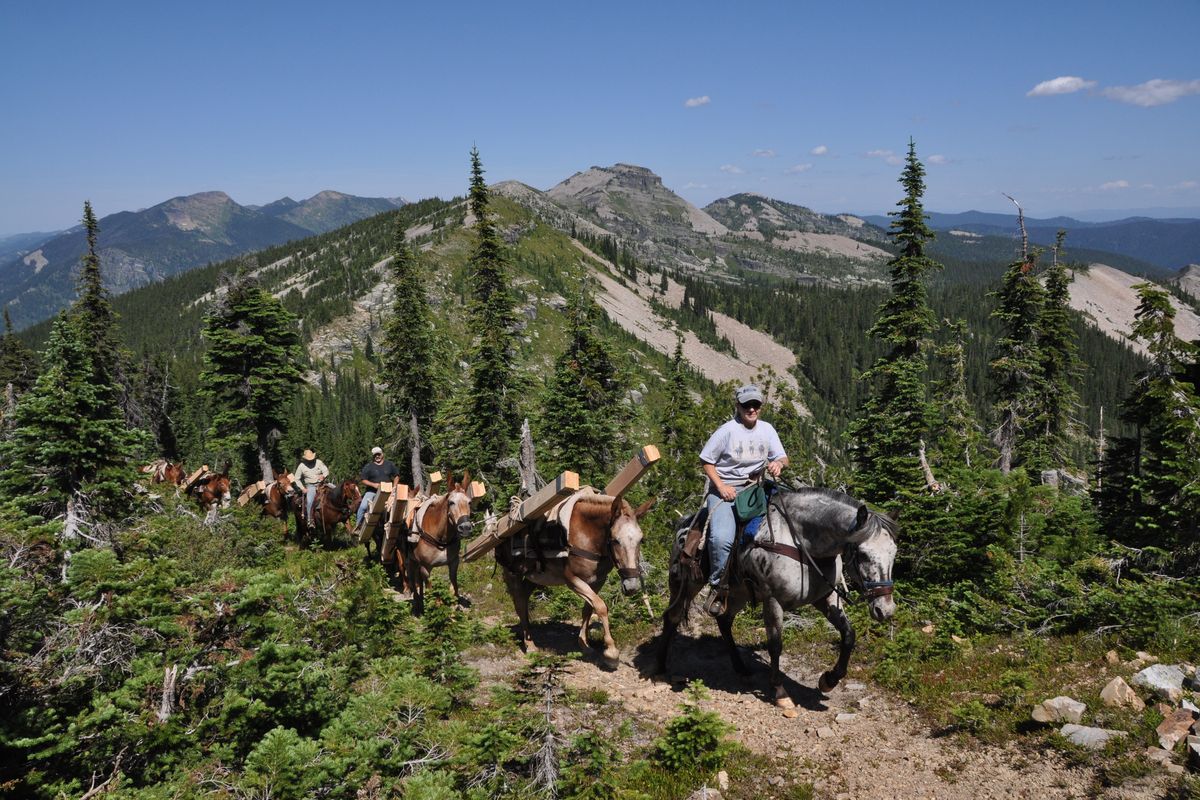Forest Service mule packers lend muscle to lookout project

The Forest Service is taking a team approach to restoring a fire lookout on a peak overlooking the Clark Fork River.
Although many helping hands are involved, the heavy lifting was done last week by a team of mules in a prestigious pack string based out of the Ninemile Historic Ranger Station and Remount Depot northwest of Missoula.
“It’s a privilege to have your project supported by the regional packers,” said Rachael Reckin, Kootenai National Forest archeologist. “We had to make our request in the spring. They get to choose which projects they handle and they’re booked all season.”
Reckin is coordinating with the Friends of the Scotchman Peaks Wilderness to restore the lookout on Star Peak, which stands out like a beacon on its perch above Heron, Mont.
Although Highway 200 traffic can be seen from the lookout, getting materials to the site requires a five-mile pack up a steep old mining road and single track trail.
“We have to pack in lumber and materials and pack out an old stove and other junk,” Reckin said.
Once the backbone of supplying backcountry lookouts, ranger cabins and camps for trail and fire crews, horses and mules are rare luxuries nowadays in national forests.
While smaller mule teams and contractors serve the backcountry needs of some individual ranger districts that include wilderness areas, the Ninemile mules are one of only two full regional specialty pack strings serving the U.S. Forest Service.
The Rocky Mountain Specialty Pack String supports forests in Colorado, Wyoming, Nebraska, Kansas and South Dakota.
Ninemile’s pack train serves some of the roughest ground in the Northern Region, a management area that is spread across 25 million acres and 12 national forests in Montana, Idaho and North Dakota.
Mark Pengelly, 54, has been Ninemile’s full-time packer since 1984 after years of cutting his teeth on everything from ranch and rodeo work to packing for hunting and fishing outfitters.
The pack string’s 10 mules and three riding horses log 800-1,000 trail miles during the late April through October season, he said.
Big male donkeys are selected for breeding with horses – sometimes even Belgians – to produce the large mules preferred by the Ninemile packers.
All of the mules are sorrel – reddish brown – so they look like a team whether they’re on the trail or in one of the many parades they grace. The pack string also is used for teaching leave-no-trace techniques.
Weighing 1,100 to 1,200 pounds, each mule can carry 180-240 pounds.
They haul between 100,000 and 500,000 pounds of gear and material in or out of the region’s roadless areas each year.
Pengelly and his one or two helpers have to lift all that weight, too, not to mention taking care of the stock and equipment year-round.
“It can take a toll,” he said, noting that gimpy knees and sore backs come with the job.
But while they lift the weight handled by an airline baggage worker in a day, they’ll treat it more gently.
“It’s counterproductive to beat up the stuff you’re packing into the forest,” Pengelly said.
Last week, Pengelly and Casey Burns out of Ninemile joined with Troy Ranger District packer Cindy Betlach to bring in dimensional lumber to Star Peak (formerly called Squaw Peak).
Boards up to 7 feet long were tied to lumber bunks on Decker pack saddles. It was an easy load for mules that have carried 12-foot-long bridge beams.
In some cases, Pengelly will rig overhead swivel bunks for tandem pack loads between two mules. “Tandems can carry posts up to 20 feet long,” he said.
Ninemile pack trains are known for their ability to haul anything anywhere, including bed springs, propane bottles, culverts, dynamite, gravel, cement and tanks of trout for stocking in mountain lakes.
“I even have chemical tank packs for my mules so a crew member can walk behind me and spray weeds,” Betlach said.
Her husband, Steve Betlach, a member of the Back Country Horsemen and volunteer on the Star Peak project, said mules are distinct from the donkeys and horses they cross to create them.
“A mule is a different animal,” he said. “They don’t fight being tangled. They tend to figure things out.”
“These are generalities,” Cindy said. “There are some very good pack horses, too. But overall, mules stand out as being more sure-footed and more at ease on steep, narrow, rocky climbing. They’re built for packing, tough as anything and they go and go.”
Betlach’s pack string, often used in the Cabinet Mountains Wilderness, includes two 30-year-old mules that were retired from the Ninemile string.
“They’re good at packing lumber, which spooks a lot of horses because they have to learn to drop their head and deal with it banging their head or poking at their ears,” she said.
“They’re next to bombproof,” Steve Betlach said. “These mules barely flinch when a couple of inexperienced trail crew throw a water bottle between their ears.
“You can start up a chain saw and they just stand there.”
On the other hand, every mule has its own personality. The packers could be heard strategizing on which mule should carry which load and which mule should lead or follow up the last rocky stretch to the Star Peak Lookout.
“Even with the best animals, things can go wrong,” Pengelly said, noting that he’s had horses or mules go lame or get sick.
“I’ve had a few 15-mile walks out to the road in my career,” he said.
Although he packs through hundreds of miles of bear habitat a year, he’s never been seriously bothered by a grizzly.
“But moose: Now that’s a different story,” he said.
“Anybody who hasn’t had a big mule wreck with his string hasn’t been a packer for long.”